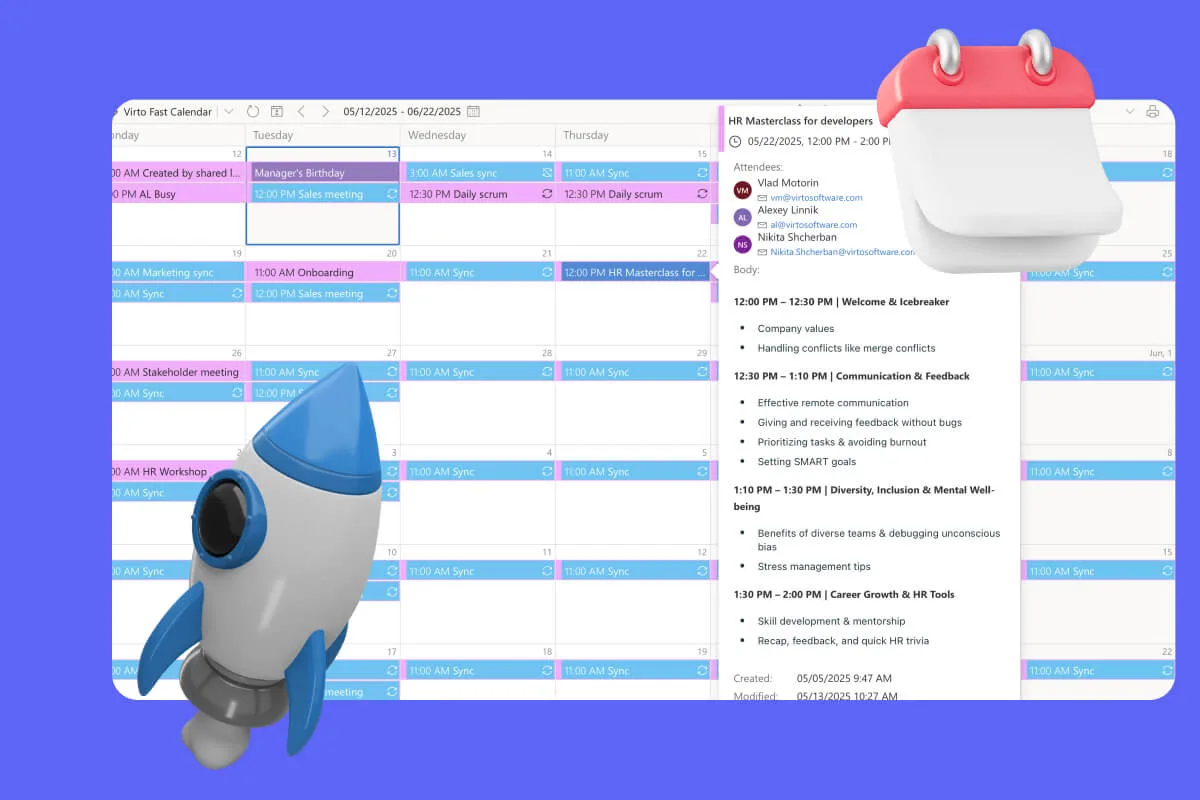There is something that might sound a bit corporate, but secretly has the power to save your projects, your teams, and maybe even your sanity: capacity planning.
So, what is capacity planning? In simple terms, it’s making sure you’ve got the right mix of people, time, and tech to get the job done—without overloading anyone or letting resources sit idle. You could even say the capacity planning definition is all about balance.
Think of team capacity planning as the “Goldilocks principle” for work: not too much, not too little, just right. Done right, capacity planning and management keeps projects on track, teams productive, and businesses running like a well-tuned server.
In this article, we’ll explain how to do capacity planning, share capacity planning best practices, and walk you through the capacity planning process from start to finish. You’ll learn:
- Which capacity planning tools and capacity planning software to consider—and how to choose the right capacity planning tool for your needs
- Capacity planning strategies (including strategic capacity planning) you can actually apply
- A real capacity planning example (or two)
- Practical templates to help you create your own capacity plan and understand what is a capacity plan in action
We’ll also touch on project management capacity planning, business capacity planning, software capacity planning, and even the different types of capacity planning—so by the end, you won’t just be able to define capacity planning, you’ll know exactly how to use it.
The benefits of capacity planning are too good to ignore. Once you master your capacity planning strategy, you’ll see why planning capacity is one of the smartest moves you can make for your team and your business.
👉Curious how teams optimize workloads? Discover practical tips in our articles:
- Proven Resource Scheduling Methods for Successful Projects
- Resource Leveling in Project Management: Key Benefits and Techniques
- Understanding Resource Smoothing in Project Management
What is Capacity Planning and Why Do You Need It?
Before we dive into charts, templates, and all those shiny capacity planning tools, let’s zoom out for a second. If you’ve ever tried to juggle multiple projects, keep a team happy, and still meet deadlines without losing your mind—you’ve already brushed up against the world of capacity planning. The catch? Most teams do it by gut feeling, which works… until it doesn’t. That’s where a solid capacity planning strategy comes in—turning guesswork into a clear, repeatable process that actually helps you sleep at night.
Definition and meaning
So, what is meant by capacity planning? In plain terms, capacity planning is a smart management process where an organization figures out exactly what resources it has—and whether those resources can handle both the current workload and whatever’s coming next.
Think of it as matching your “engine power” to the road ahead. In the capacity planning process, you’re lining up your available capacity with the planned workload to avoid burnout, downtime, and costly inefficiencies.
A good capacity plan takes into account things like:
- The number of available team members and their specializations (team capacity planning)
- Current workload and what’s forecasted for the future
- Technical and financial resources (software capacity planning, budgets, equipment)
- Deadlines and delivery timelines
In other words, capacity planning and management is about keeping the balance between resource demand and supply—especially for companies working on tight deadlines, limited budgets, or complex internal structures. Done well, it’s the difference between running at full speed with control and spinning out on the first corner.
👉What is meant by capacity planning? Capacity planning means figuring out exactly what resources—people, time, budget, and technology—you have, and matching that “capacity” to your current and future workload so you can deliver projects on time without overloading your team or leaving resources unused; it’s the process of balancing demand and supply to keep work flowing efficiently.
Why capacity planning matters
Alright, so what is the importance of capacity planning? Let’s break down the biggest reasons every business—from lean startups to sprawling enterprises—needs it:
- Prevent employee overload – without capacity planning management, it’s easy to end up with some team members drowning in work while others twiddle their thumbs. Planning capacity helps spread the load fairly.
- Hit project deadlines – when you know exactly what resources you have, project management capacity planning becomes far more accurate, and deadlines stop being moving targets.
- Improve forecasting accuracy – by using historical data and analyzing current workloads, business capacity planning turns guesstimates into actual, reliable projections.
- Control budgets & cut costs – a well-executed capacity planning strategy avoids budget overruns and reduces last-minute hiring or outsourcing.
- Optimize resources – instead of guessing who’s free and what’s available, you’ll have a clear picture thanks to your capacity planning tools and capacity planning software.
- Stay resilient – External changes? Shifting priorities? Sudden staff changes? With strategic capacity planning, you can adapt quickly instead of scrambling.
The benefits of capacity planning boil down to this: fewer surprises, smoother workflows, and smarter decision-making. And when you’ve mastered how to do capacity planning using the right capacity planning best practices, you’ll wonder how you ever managed without it.
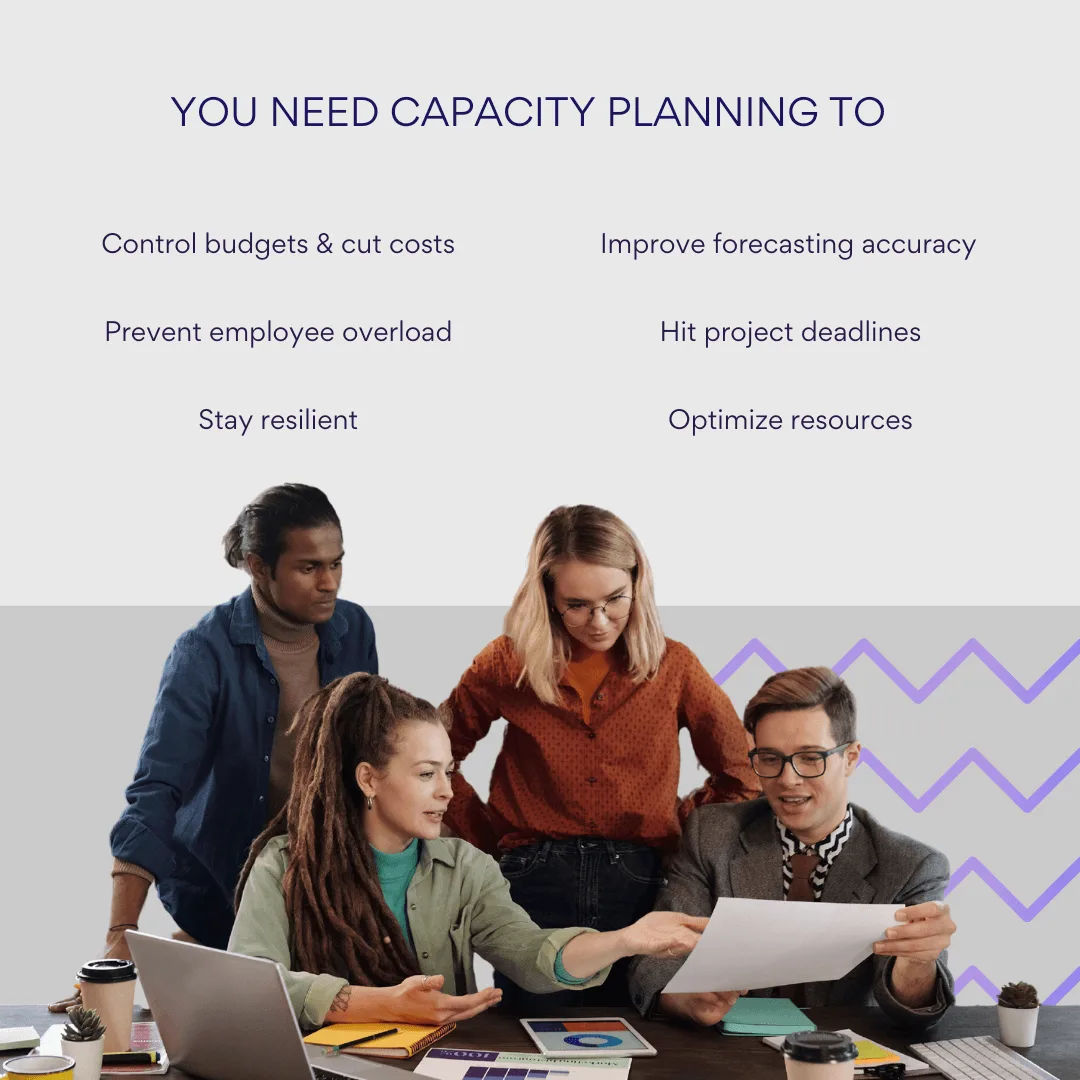
👉What is the importance of capacity planning? The importance of capacity planning lies in its ability to keep projects on track, teams balanced, and budgets under control by ensuring you have the right resources in the right place at the right time; it helps prevent employee burnout, avoid costly downtime, improve forecasting accuracy, adapt quickly to changes, and make smarter decisions that drive both efficiency and long-term business success.
Stages and the Capacity Planning Process
So, how to create a capacity plan that actually works? Think of it as a five-step recipe for balancing your team’s workload, your resources, and your deadlines—without burning out your people or blowing up your budget. The capacity planning process is straightforward, but the magic is in doing each step with both numbers and nuance in mind.
1️⃣ Assess current workload and available resources
Every good capacity planning strategy starts with knowing exactly where you stand today. That means collecting real data on your team, tools, and budget:
- Who’s working on what, and how busy they are (team capacity planning)
- Which capacity planning tools, equipment, and funds are already in play
- What projects or tasks are already running
- Known blockers or bottlenecks that could slow things down
And here’s the key: don’t just count heads—look at skills. Instead of “five developers,” note that you have “two frontend, one backend, and two QA.” That level of detail makes capacity planning and management far more accurate.
2️⃣ Forecast resource demand
Once you know your current load, it’s time to predict the future. This is where strategic capacity planning shines:
- Upcoming projects, launches, or marketing campaigns
- Seasonal spikes in activity
- Expected company or team growth
- Quarterly or annual strategic goals
To make forecasts reliable, lean on historical data, sales plans, department head estimates, and even analytics from your capacity planning software. This step turns “we think” into “we know.”
3️⃣ Identify gaps between resources and demand
Here’s where you compare what you have with what you’ll need. This stage of capacity planning management often reveals:
- A shortage of people or key skills
- Overloaded team members
- Idle resources gathering dust
- Risks that could derail timelines
This is also the moment to spot opportunities—maybe you can reassign talent instead of hiring, or automate repetitive work.
4️⃣ Build a balancing plan
Now we adjust. A strong capacity plan might involve:
- Redistributing tasks and responsibilities
- Hiring new staff or bringing in contractors
- Delaying or reprioritizing projects
- Using automation or external solutions to ease the load
The plan should be realistic, achievable, and agreed upon by everyone involved—because even the best capacity planning strategies fail without buy-in.
5️⃣ Monitor and adjust continuously
The work doesn’t end when the plan is written. Ongoing capacity planning and management means regularly:
- Tracking plan execution
- Checking actual workloads
- Spotting deviations early
- Reassigning tasks or shifting schedules as needed
Digital tools like shared calendars, Kanban boards, or task trackers make this stage faster, more transparent, and much less painful. With the right capacity planning tool, adjustments become quick tweaks instead of stressful fire drills.
👉How to create a capacity plan? To create a capacity plan, start by assessing your current resources—people, skills, technology, and budget—and mapping out exactly who’s working on what. Next, forecast future demand by considering upcoming projects, seasonal peaks, growth plans, and strategic goals. Compare your available capacity with the expected workload to spot gaps, whether it’s missing skills, overloaded staff, or idle resources. Then, build a realistic capacity planning strategy to close those gaps—this could mean redistributing work, hiring, delaying projects, or using automation. Finally, monitor and adjust regularly using capacity planning tools so your capacity plan stays accurate as priorities, deadlines, and resources shift.
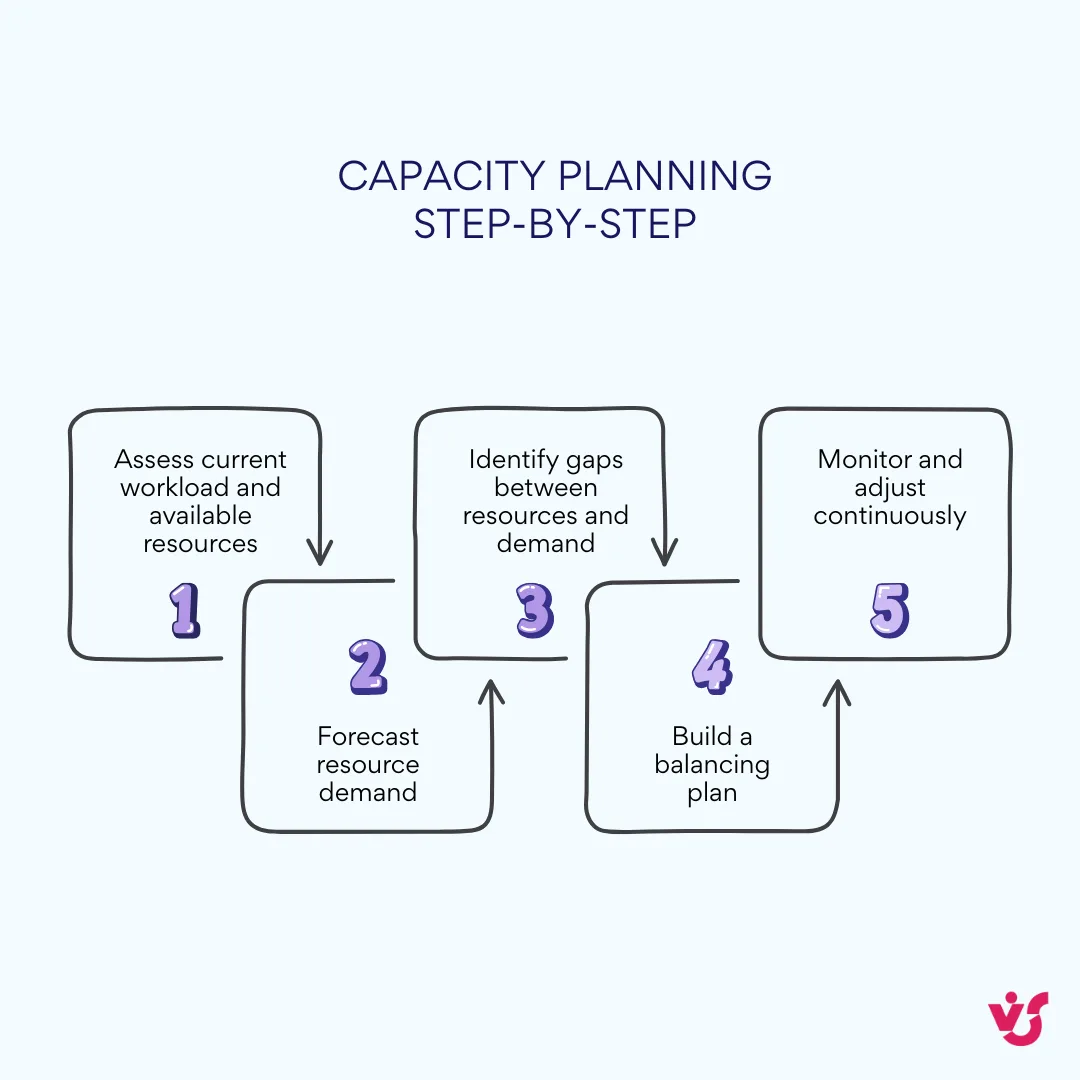
Examples and Templates for Capacity Planning
So, what is an example of capacity planning in the real world? Let’s say you’ve got a software development team juggling three different projects, all with different deadlines. Some developers are rockstars at backend logic, others shine in frontend design, and a few are QA wizards. A smart capacity planning strategy would map out each person’s skills, availability, and deadlines, then allocate tasks so nobody is overloaded, nothing gets bottlenecked, and all projects move forward in sync.
This is where capacity planning tools and capacity planning software make life a lot easier. Instead of managing a dozen spreadsheets by hand, you can visualize the entire capacity planning process—time, skills, resources, priorities—at a glance.
Practical examples
- Development team with multiple deadlines
Use team capacity planning to assign backend, frontend, and QA work based on availability, skill, and project priority.
- Marketing department preparing for a product launch
Apply strategic capacity planning to coordinate content creation, design, and ad campaigns so everything goes live on schedule.
- IT support team during peak season
Use business capacity planning to staff shifts according to predicted ticket volume.
👉What is an example of capacity planning? An example of capacity planning is a software development team working on several projects at once—each with different deadlines and skill requirements—where the project manager uses a capacity planning tool to map out every developer’s availability, match tasks to the right skills (frontend, backend, QA), and schedule work so no one is overloaded, resources are fully used, and all projects move forward on time.
Templates you can use
Ready-made capacity planning templates save a ton of time—especially when you’re just starting out, handling repeatable processes, or onboarding new managers. Some go-to formats include:
- Excel or Google Sheets tables – simple columns for task, project, assignee, estimated hours, deadline, and status. Perfect for lightweight capacity planning management.
- Gantt charts (Microsoft Project, Asana, Virto Calendar) – great for project management capacity planning, showing exactly who’s working on what and when.
- Calendar templates with time blocking – Ideal for weekly or monthly capacity planning best practices; see instantly where you’ve got free capacity vs. overload.
Tips for using templates
✅At the beginning, start with a ready-made template and tweak it for your needs.
✅After a few iterations, create your own capacity plan tailored to your team’s workflow.
✅Use cloud-based capacity planning tools so everyone can view and update in real time.
✅Keep it visual—colors, charts, and clear timelines make capacity planning and management more intuitive.
With the right examples, templates, and capacity planning software, you’ll go from wondering “what is a capacity plan?” to running a fully optimized, resource-balanced operation.
Explore VirtoSoftware Apps for Team Capacity Planning
Capacity Planning Strategies and Best Practices
When it comes to capacity planning and management, there’s no one-size-fits-all playbook. The right capacity planning strategy depends on your team’s size, industry, and growth stage. Let’s break down the main approaches, along with their strengths and pitfalls.
Capacity planning strategies
| Strategy | Details | Benefits | Risks |
| Just-in-time strategy | Perfect for fast-moving Agile teams, this approach keeps resources at the bare minimum and scales them only when needed. It’s common in IT, marketing, and consulting. | ✅Cost optimization ✅Maximum flexibility | ❗️Resource shortages during peak demand |
| Lead strategy (with reserve) | This proactive capacity planning strategy builds extra resource capacity ahead of forecasted demand. It’s a favorite in manufacturing, logistics, and eCommerce. | ✅Readiness for peaks ✅Reduced risk of missed deadlines | ❗️Underutilized resources ❗️Higher costs |
| Lag strategy (reactive) | You add resources only after consistent demand appears — popular in small businesses and budget-conscious teams. | ✅Avoids unnecessary spending | ❗️Missed opportunities ❗️Late deliveries when demand spikes unexpectedly |
| Match strategy (balanced) | A hybrid approach that blends all the above: constant monitoring, gradual scaling, and adapting to changing goals. | ✅Adaptability ✅Controlled growth | ❗️Strong analytics ❗️Disciplined execution |
Capacity planning best practices
To make capacity planning a natural part of your workflow, these capacity planning best practices are worth embedding into your daily and weekly routines:
| Best practice | Why it matters |
| ✔️Tie it to business goals and KPIs | Your capacity plan should connect directly to strategic and operational priorities so every resource decision supports the bigger picture. |
| ✔️Leverage historical data | Past projects, seasonal trends, and workload reports are gold for improving forecasting accuracy. |
| ✔️Run regular reviews and monitoring | Weekly or sprint check-ins help compare the capacity planning process to reality, so you can pivot fast. |
| ✔️Visualize your plan | Use calendars, Gantt charts, or dashboards from capacity planning tools to make resource loads, priorities, and deadlines crystal clear. |
| ✔️Involve all stakeholders | Capacity planning management works best when department heads, project managers, HR, and analysts contribute. |
| ✔️Stay flexible and adaptable | Plans should evolve as priorities or external conditions change. |
| ✔️Plan for risks in advance | Build in buffers for time, budget, and resources so surprises don’t derail progress. |
| ✔️Automate where possible | Use capacity planning software like Microsoft Planner, Asana, or Virto Calendar for real-time updates and collaboration. |
By combining the right types of capacity planning with consistent best practices, you’ll have a system that scales with your team and delivers predictable, data-driven results.
Capacity Planning Software and Tools
So, what is capacity planning software? In short, it’s a set of digital tools designed to help you see exactly what resources you have, predict upcoming workloads, and keep your team balanced and productive. A good capacity planning tool doesn’t just store data—it analyzes available resources, forecasts demand, visualizes workloads over time, and even suggests how to redistribute tasks automatically. The right software can make team capacity planning, business capacity planning, and project management capacity planning faster, more accurate, and far less stressful.
Whether you’re running an IT department, HR team, manufacturing line, or a portfolio of projects, modern capacity planning tools can help you:
- Analyze your current team and resource availability
- Forecast workload for future projects
- Visualize schedules and priorities in real time
- Automate resource reallocation to avoid overloads and downtime
- Collaborate effectively with stakeholders
Popular capacity planning tools – comparison table
| Tool | Description & focus | Best for | Integrations | Visualization options | Team collaboration | Price range | Pros | Cons |
| Monday.com | Visual capacity planning tool with boards, timelines, and automation. Strong integrations. | Marketing, HR, cross-department teams | Slack, Teams, Google, MS365, CRM | Timelines, Kanban, workload view | Yes | $$ – $$$ | Highly visual, user-friendly | Advanced features can get pricey |
| Virto Calendar | Visual calendar app with capacity planning for SharePoint and Microsoft 365. Supports time blocking and tracking. | Microsoft-focused enterprises and SMEs | SharePoint, MS Teams, Outlook | Calendar, time blocking, workload | Yes | $ – $$ | Seamless Microsoft integration, visual time blocking | Best suited for Microsoft environments |
| Float | Specializes in team capacity planning and scheduling with drag-and-drop and skill tagging. | Agencies, service-based teams | Google, Outlook, Asana, Trello | Calendar, workload charts | Yes | $$ | Simple, quick to set up | Limited project management depth |
| ClickUp | All-in-one platform with tasks, docs, and capacity planning management features. | Teams wanting one tool for everything | Google, Slack, GitHub, Zapier | Gantt, calendar, workload view | Yes | $ – $$ | Flexible, customizable | Can feel overwhelming at first |
| Jira + Advanced roadmaps | Agile-friendly capacity planning software for software dev, roadmaps, sprints, and backlog management. | IT and dev teams | Bitbucket, GitHub, Slack, MS365 | Roadmaps, sprint boards, burndown | Yes | $$ – $$$ | Deep Agile support | Steeper learning curve for non-technical teams |
| Microsoft Project | Classic project management capacity planning solution with Gantt charts, budgeting, and reporting. | Large enterprises, complex portfolios | MS365, Power BI, Dynamics | Gantt, calendar, dashboard | Yes | $$$ | Powerful and detailed | Heavy interface, higher cost |
| Smartsheet | Spreadsheet-style capacity planning tool with automation and collaboration. | Operations, manufacturing, logistics | Google, MS365, Salesforce | Grid, Gantt, calendar | Yes | $$ – $$$ | Familiar spreadsheet feel | Not as visually rich as others |
👉What is capacity planning software? Capacity planning software is a digital tool that helps teams and companies understand how much work they can realistically handle by analyzing available resources (people, time, budget, equipment), forecasting demand, and visualizing workload distribution. It automates the process of tracking capacity, highlights resource bottlenecks, and suggests how to reallocate efforts so projects stay on track. In practice, such software often includes dashboards, calendars, Gantt charts, and integrations with project management platforms, making it easier to balance demand and supply, avoid overload, and plan team work efficiently.
How Virto Supports Capacity Planning
Virto Calendar App is a powerful tool for capacity planning, especially for organizations working with Microsoft 365 and Microsoft Teams. It helps managers and teams coordinate availability, allocate resources, and optimize workloads, making it highly effective for team capacity planning in dynamic and distributed environments. Here’s how it works:
1. Centralized team availability calendar
Virto Calendar App brings together schedules from multiple team members, projects, and locations into a single view. This makes it easier to see the overall workload, balance the capacity plan, and prevent overbooking.
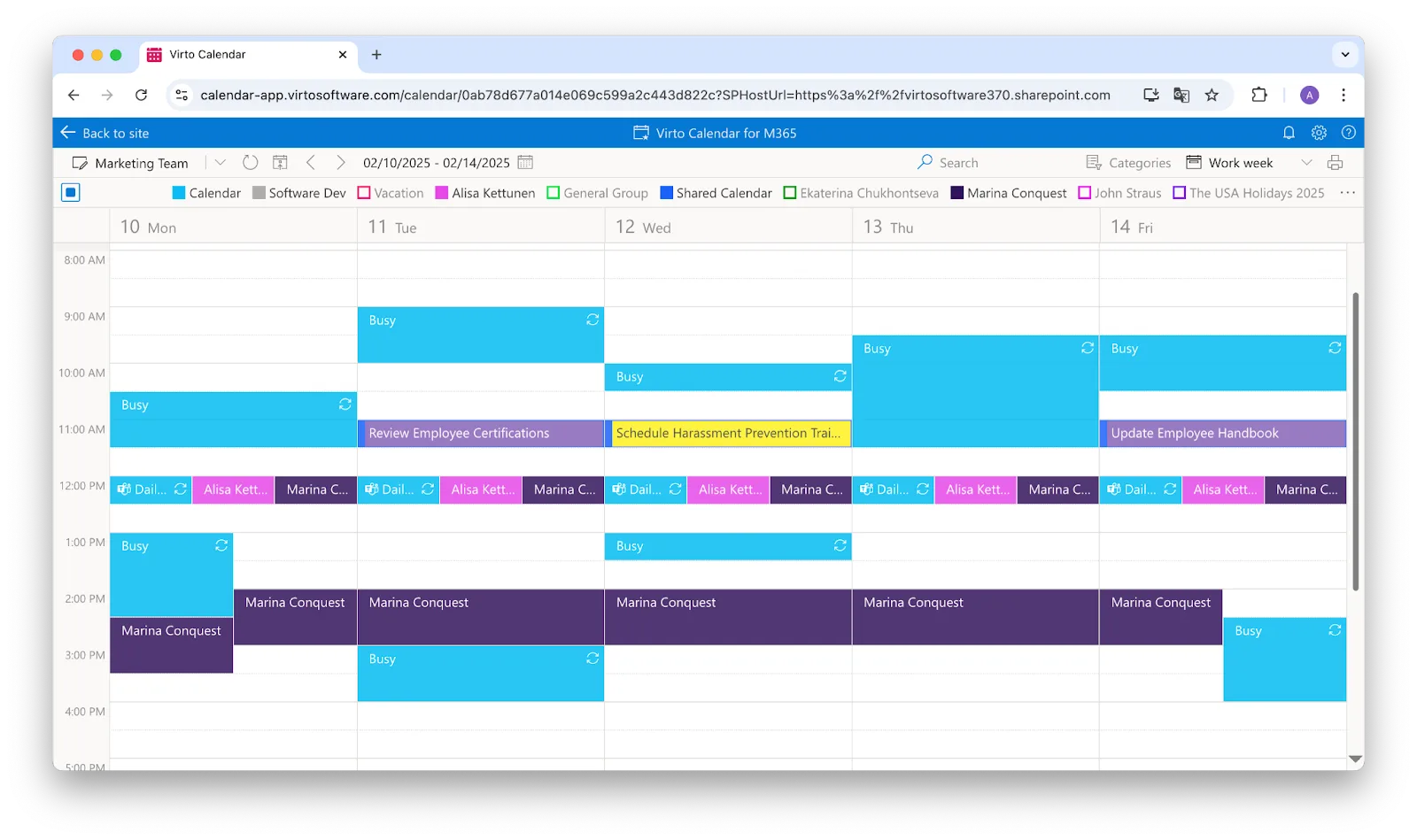
2. Resource planning
The tool allows you to plan not only people but also shared resources such as meeting rooms, equipment, or facilities. This ensures resources are not overused and supports a smoother capacity planning process across projects or shifts.
3. Visual workload overviews
With daily, weekly, and monthly calendar views, managers can quickly assess team capacity at a glance. Color coding and filtering make it simple to spot potential bottlenecks, overloads, or underutilized resources.
4. Recurring tasks and shift planning
Virto Calendar App supports recurring events and shift-based scheduling, which is essential for teams with rotating workloads. This makes it easier to manage staffing needs and ensure continuous coverage.
5. Integration with Microsoft Teams
Because the Virto Calendar App works directly inside Microsoft Teams, all updates are instantly visible to the whole team. Managers can adjust schedules in real time without switching between tools, making capacity planning seamless.

6. Alerts and notifications
Built-in alerts and reminders help teams stay on track, avoid double bookings, and reduce the risk of missed deadlines — increasing overall efficiency and alignment.
Using Virto Calendar App for team capacity planning
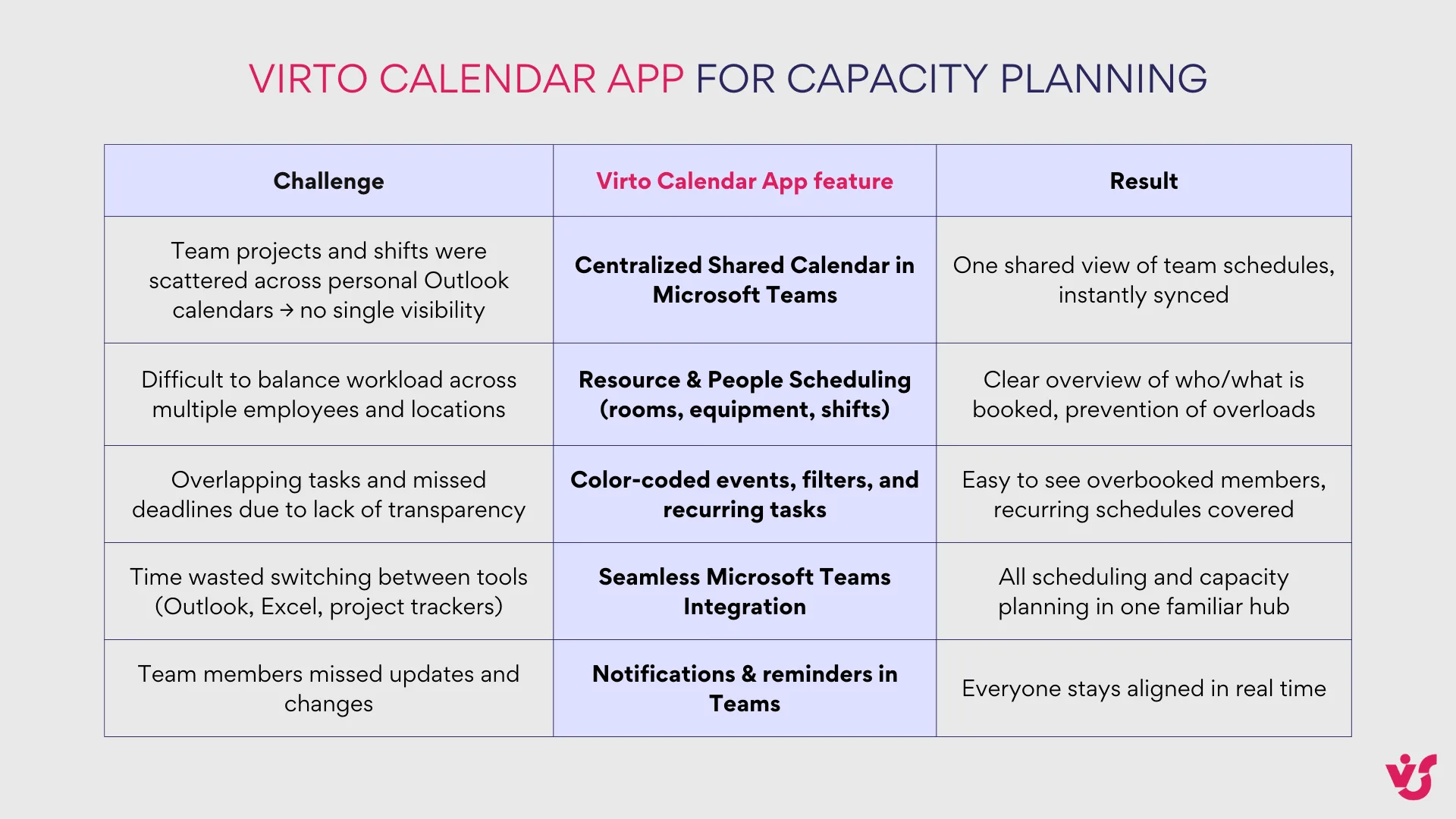
Why choose Virto Calendar App?
Stay on top of your team’s workload without switching tools! Use the Virto Calendar App for Microsoft Teams to manage schedules, resources, and capacity planning right inside Teams. Prefer SharePoint? The Virto Calendar App for SharePoint & Microsoft 365 brings the same powerful planning and visualization directly into your SharePoint environment. Two products, one goal: smarter, simpler capacity planning.
Capacity planning flow with Virto Calendar App
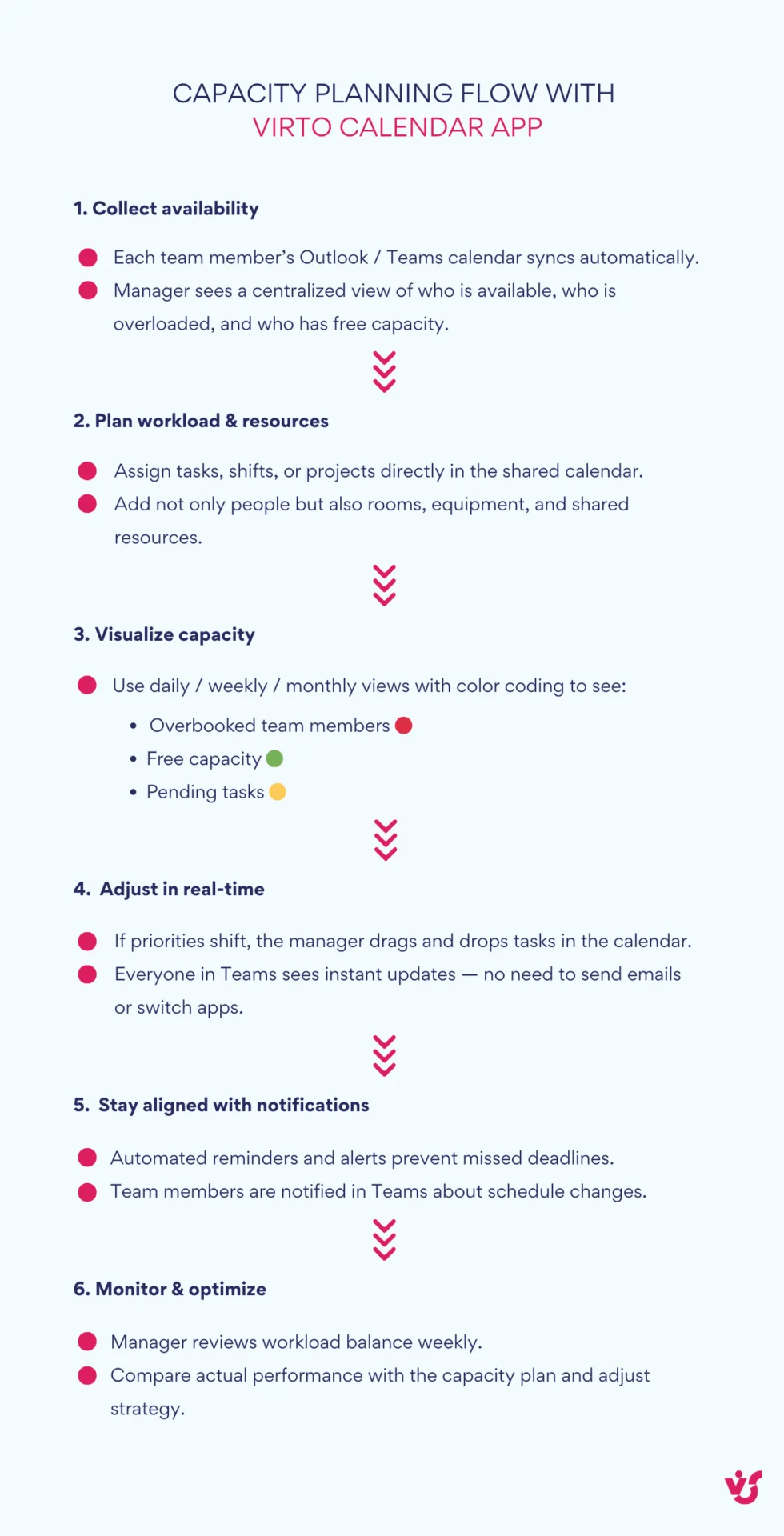
Virto Shared Calendar
In addition to the Virto Calendar App, Virto also offers the Virto Shared Calendar — a lightweight, easy-to-deploy solution that works seamlessly in SharePoint and Microsoft Teams. While the Virto Calendar App is ideal for enterprise teams with complex projects, Virto Shared Calendar is perfect for small and mid-sized businesses that need a quick, collaborative way to manage schedules and align capacity planning without heavy setup.
Both tools can be used for:
- Tracking team availability and workload.
- Scheduling people, rooms, and equipment.
- Visualizing capacity planning strategies (Lead, Lag, Match, JIT).
- Improving resource utilization and reducing downtime.
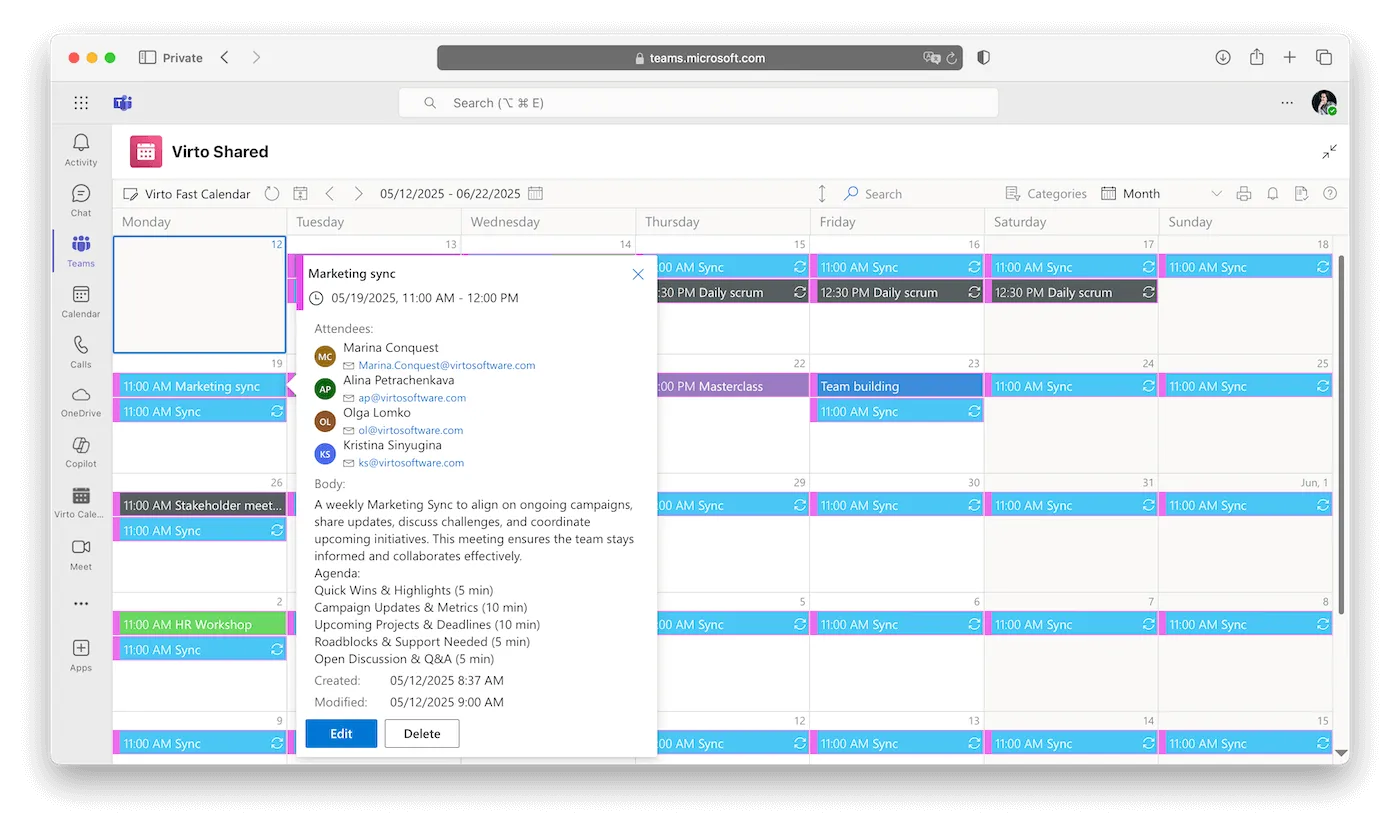
Case example
A software development company using Microsoft Teams adopted Virto Shared Calendar to manage multiple project teams with overlapping deadlines. By centralizing schedules, they were able to:
- visualize workload across departments
- prevent over-allocation of developers
- reserve resources like testing environments in advance
- keep everyone aligned within Teams.
As a result, their capacity planning process became more transparent, reducing scheduling conflicts and helping deliver projects on time.
Explore VirtoSoftware Use Cases for Capacity Planning
With this dual approach, Virto gives organizations flexibility:
- Virto Calendar App → Best for large enterprises with advanced project management needs.
- Virto Shared Calendar → Best for small businesses and agile teams who want a simple yet effective tool for business capacity planning.
Conclusion
Effective capacity planning isn’t just a one-off task—it’s a systematic approach to managing your team, projects, and resources for sustainable growth. By understanding your team’s availability, balancing workloads, and forecasting demand, companies can avoid bottlenecks, reduce downtime, and deliver projects on time.
Using digital tools makes this process faster, more accurate, and far less stressful. Among them, the Virto Calendar App shines for teams working in Microsoft Teams, turning capacity planning into a simple, visual, and automated workflow. With it, you can finally see who’s available, what resources are free, and how to allocate your team most effectively—without juggling multiple platforms or spreadsheets.
Ready to make capacity planning effortless? 🚀
- Try the Virto Calendar App for Microsoft Teams to manage schedules, workloads, and resources directly in Teams.
- Or check out the Virto Calendar App for SharePoint & Microsoft 365 for seamless planning and visualization right inside SharePoint.
Two tools, one goal: smarter, simpler capacity planning that keeps your team balanced and your projects on track.
👉More on automating and visualizing your team’s workload in our articles:


